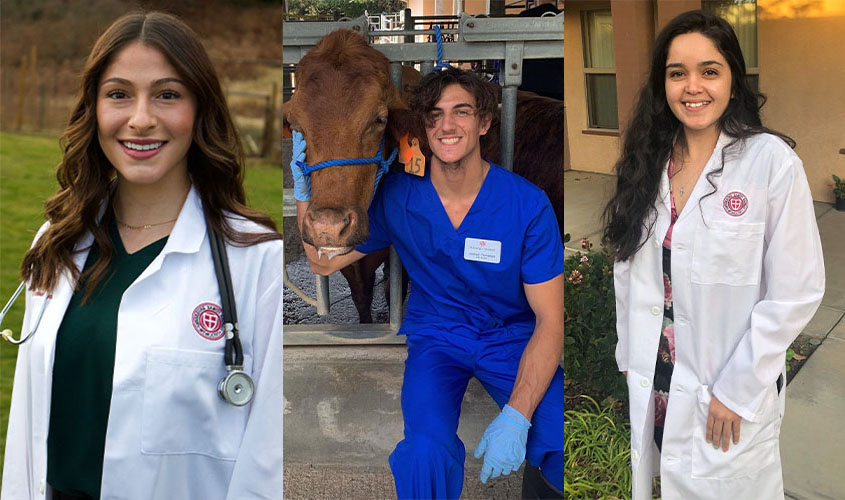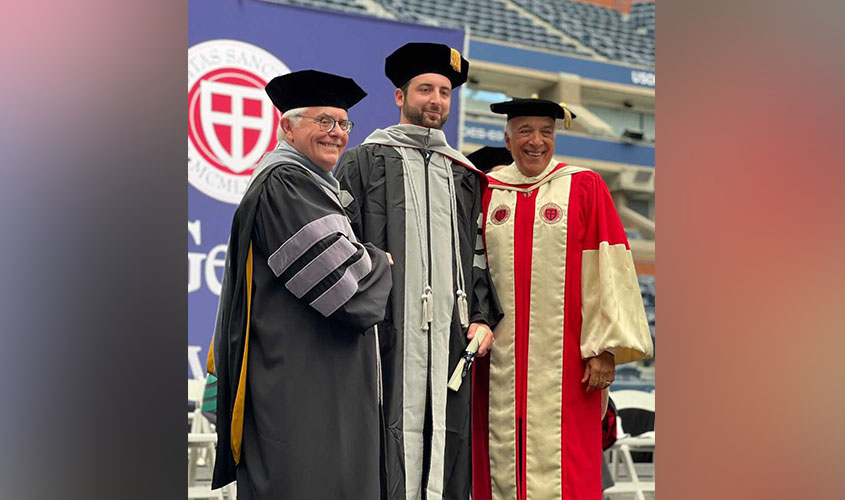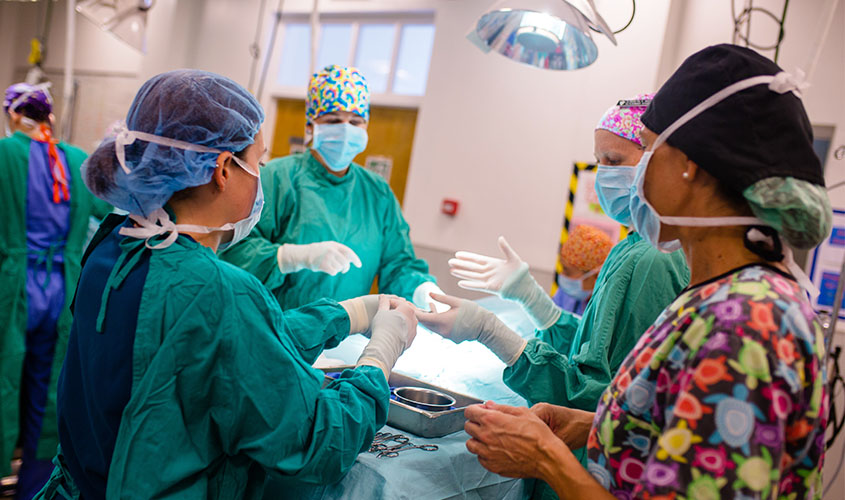
The School of Veterinary Medicine celebrated its Spring 2022 Term Awards on April 23 during a virtual event that included students, faculty, and staff.
Dr. Tara Paterson, SVM awards committee chair, opened the ceremony by remarking on the significance of the night: “Even though we are not all together celebrating in the same room or space, it doesn’t take away from the magnitude of the occasion. We hope that you enjoy spending the next hour with us celebrating your colleagues, your faculty, the staff, and all the wonderful things that contribute to making SGU such an amazing institution.”
Vice Provost of Institutional Advancement Brendan LaGrenade also addressed the virtual crowd. He shared his thoughts on continuing the ceremony virtually, and how it “is a testament to how important these awards are” to showcase students’ and faculty’s achievements. “I also feel compelled to add that you vets know how to make academia interesting and fun,” he added.
Over 20 sets of awards were presented during the event, including the first for SVM’s Surgery Club—the Sharpest Scalpel Award. Also of note was the Award for Outstanding Service to SGU honoring Dr. Rolf Larsen who will retire at the end of this term, and the induction of 26 students into the Alpha Delta Chapter of the Society of Phi Zeta.
“We at the School of Veterinary Medicine are proud to recognize the success and achievements of our students, faculty, and staff,” said Dr. Neil Olson, dean of the SVM, in the final welcoming remarks to kick off the night and begin the presentation of awards.
This semester’s awards are as follows:
Outstanding Colleague Awards
Term 1 : Stephanie West
Term 2: Andrew Richterkessing
Term 3: Treg Brown
Term 4: Maureen Kruhlak
Term 5: Madison Kucinick
Term 6: Yvonne White
Dean Olson’s Award for Academic Excellence
Joshua Fornengo, Jennifer Maguire, Emily Schafsteck, Paige Coughlin, Jacob Dempsey, Brenda Ruiz Anaya, Ericah Roncone
Adrienne Lotton Memorial Award
Sheriden Nicholes
Zoetis Revolution Awards of Excellence
Small Animal Internal Medicine: Ida Yates-Lavery
Small Animal Surgery: Sheriden Nicholes
Equine Medicine and Surgery: Chloe Eaton
Food Animal Medicine and Surgery: Thomas Ramsey
Scholarship of Service: Tyler Epes
Surgery Team: Alexa Cameron, Acacia Johnson, Andrew Yacoub, Stephanie Smick
Student Research Award: Sara Schectman
SVM Alumni Scholarship Award
Madison Whitney
Giant Paws Giant Hearts Foundation “Hercules” Award
Sheriden Nicholes
PAWS Recognition Sixth Term Facilitators
Patrick Donegan, Ireny Barsoum, Brittany Riddick, Parveen Hothi, Michelle Mordukhaev
Feral Cat Project
Most Valuable Trapper: Emily Shin
Most Valuable Faculty/Staff: Dr. Wayne Sylvester
Veterinary Public Health Committee
One Health One Medicine Community Leader Award: Mallory Peak
SGUSVM Large Animal Society
Ace of Initiative Award: Melitsa Iaonnou
Most Valuable E-Board Member: Megan Gilmore
Student Chapter of the Society for Theriogenology
Therio-Hero: Ashley Emmett
Top Dam: Amanda Rottman Torres
AAARF: Angels in Armor Animal Rescue Fund
Friends of AAARF Award: Tyler Epes
SCACVIM: Student Chapter of the American College of Veterinary Internal Medicine
Internal Medicine MVP Award: Madison Whitney
SVECCS: Student Chapter of the Veterinary Emergency & Critical Care Society
Outstanding 6th Termer: Shelby Morales
Outstanding Member: Richard Joyce and Taryn Willamson
SNP: Spay Neuter Pothound
Pothound Faculty/Staff Hero Award: Dr. Marta Lanza Perea
Pothound Student Hero Award: Brooke Bray
SCACVP: Student Chapter of the American College of Veterinary Pathologists
The MVP (Most Valuable Pathologist): Glenna Maur
EWS: Exotics & Wildlife Society
The Tenacious Turtle Award: Rayner LeBlanc
EWS Wildest Faculty Award: Dr. Sophie Moittie
VBMA: Veterinary Business Management Association
Outstanding E-Board Member: Letty Bonilla
Impact Award: Meena Khoram Pierce
AWB: Animal Welfare and Behavior Committee
AWB Excellence Award: Jasmine Simmons
SVM Surgery Club
The Sharpest Scalpel Award: Maricella Medina
SGA: Student Government Association
SGU SVM Outstanding Faculty Term 1-3: Dr. Hector Zerpa
SGU SVM Outstanding Faculty Term 4-6: Dr. Thomas Hanson
SGA SGU Awards of Excellence Term 1-3: Dr. Peter Slinger
SGA SGU Awards of Excellence Term 4-6: Ms. Elizabeth Peach
George B. Daniel Award: Sheridan Nicholes
The Pinckney Parasitology Award
Logan Bernstein
DES Recognition Awards
Amanda Via, Amanda Rottman, Cobi Guilbeau, Courtney Manly, Kira Rasmussen, Taylor Stanton
Alpha Delta Chapter of the Society of Phi Zeta
Spring 2022 Inductees
Term 5: Caitlyn Coartney, Lauren Fleming, Alexandra Garrett, Stephanie Ho, Samantha Hoover, Acacia Johnson, Jennifer Memleb, Madeline Muntean, Teylor Nealy, Samuel Ruch, Valerie Savino
Term 6: Madeleine Christen, Zachary Collette, Rachel Gray, Ida Yates-Lavery, Jenny Liu, Jenna McCartin, Jacob Moise, Brittany Murray, Jacqueline Nunnelley, Kyle Pinney, Brittany Riddick, Johana Maldonado-Ross, Rachel Uvaydov, Madison Whitney, Marielis Guzman-Sanchez
Faculty Inductees
Veterinary Faculty: Dr. Hector Zerpa and Dr. Mercedes Velazquez de Zerpa
Honorary Faculty: Ms. Janella Edwards
Spring 2022 Phi Zeta Scholarship: Jennifer Memleb
SGUSVM Award for Outstanding Service
Dr. Rolf Larsen
SGUSVM Outstanding Staff Awards
Technical Staff: Renata Mandbodh-Mitchell
Administrative Staff: Cherry-Ann Lumpriss
Zoetis Distinguished Veterinary Teacher Award
Dr. Stacey Byers
– Sarah Stoss
Related Reading






























